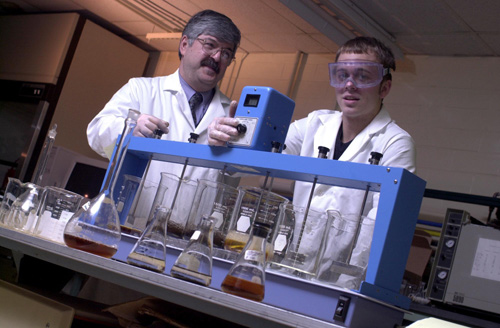A project to remove color from the wastewater effluent of pulp and paper plants is continuing this semester through funding from Lafayette and an industry partner that could benefit from the research.
Mazandaran Wood & Paper Industries has contributed $5,841 and Lafayette $12,143 for an EXCEL Scholars project conducted by Javad Tavakoli, associate professor and head of chemical engineering, with sophomore chemical engineering majors Naa Quarcoo (Accra, Ghana) and Garret Nicodemus (Lake Charles, La.).
“We did some preliminary work, and when we reported it to the company, it agreed to support the proposal for continuation,” says Tavakoli. Quarcoo began the project in the summer and continued in the fall. Nicodemus continued it by himself over the interim session and now students both are working on it.
Removal of the coloring would address neighbors’ concerns and mitigate the effluent’s effect on the light absorption of water organisms.
“When the pulp is treated and bleached and chemicals are added to make the paper into whatever form the company wants, these chemicals all end up being treated before the water is placed back into the stream,” says Nicodemus. “However, the effluent has a brown tint to it that can’t be treated, although the company tests it to make sure it is environmentally safe. The project deals with how to decolorize the effluent so it is pure and clear again, using an absorption method.”
Adds Quarcoo, “The current method of removing the color is very expensive. And although there is no EPA regulation on the color, it affects the plants and animals in the water. So the research is about finding an economical method before there are die-outs in the area.”
Quarcoo began her research by making paper to find out which step of the process produces the color. “Most of the color comes from the pulp bleaching process,” she says, adding that the varied composition of the raw wood complicates the problem-solving process.
The most promising solution identified by Quarcoo is activated charcoal, which absorbs the color without altering the chemical nature of the wastewater. This semester’s work is focused on further analyzing this method and presenting a report and funding proposal for further research to Mazandaran.
“Charcoal is relatively cheap and can be used over and over again. It doesn’t lose its potency,” she says. The second method she identified, after studying five or six techniques, is sodium percarbonate, which forms a sludge and may not work out as well.
The project also has involved study of photodegradation using UV radiation. “We have promising results there, but the applicability of that is still being investigated,” says Tavakoli. “UV lamps by themselves did not help in a reasonable timeframe, but when titanium oxide was added as a catalyst, they achieved color removal.”
The EXCEL work has been interesting, says Quarcoo, who expects to enter the research field as a career, although she wants to find new products for industry rather than studying wastewater. “You get to learn a lot and get to know what your future’s going to be about,” Quarcoo says of EXCEL. “I can see that I’ll be spending a lot of my life in the lab.”
A graduate of Achimoca School in Accra, Ghana, Quarcoo is vice president of Lafayette African and Caribbean Students Association, and a member of the International Students Association and Lafayette Christian Fellowship. She works at Kirby Sports Center and in the chemical engineering department.
Nicodemus is chair of recreation for Lafayette Activities Forum and works in Recreation Services as an event supervisor and intramural scorekeeper. In addition, he is a residence adviser and will be taking part in a service project in Honduras as part of Alternate Spring Break.

Garret Nicodemus ’03, a chemical engineering major, examined ways to remove color in paper-manufacturing runoff in EXCEL research with Javad Tavakoli, associate professor and head of chemical engineering.
